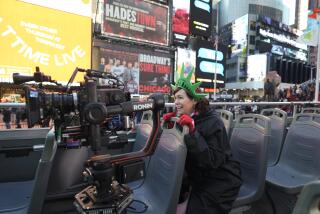It’s Still Not Business as Usual in N.Y.
- Share via
NEW YORK — New York City wasn’t just a target of the Sept. 11 terror attacks. It also was among the regions hardest hit by the national recession and resulting downturn in tourism and business travel.
Both business and tourist travel to the city have picked up since the bleak days of late 2001, but business traffic is recovering much more slowly, experts say.
“It’s still not close to being back,” said economist Ken Goldstein of the Conference Board, a Manhattan-based business research organization. “The business traveler has been a missing ingredient in the New York economy, and a full recovery in business travel is at least six months away and easily 12 to 18 months.”
Goldstein and other experts on the local economy believe that corporate belt tightening, not lingering post-9/11 security concerns, is the major reason business travel to the city remains slow.
“It’s not a fear of flying; it’s a fear of spending money,” said John Fox, senior vice president in the Manhattan office of PKF Consulting. Its clients include NYC & Co., the private nonprofit corporation that serves as the city’s convention and visitors bureau.
He estimates that business travel to the city is off by a fourth to a third from its recent peak in the fall of 2000. As a result, he said, prices for lodging have fallen from pre-recession levels. Hotel rooms averaged $210.74 a night last October, Fox said, compared with $262.59 in October 2000.
“We’re still well above a lot of other major cities,” he said, “but not as much as before 2000.”
But visitors to the Big Apple shouldn’t expect to find hotel managers standing on the sidewalks soliciting business. Occupancy rates last year averaged a healthy 75% in Manhattan, Fox said. Although down from the record 84% pre-recession average, it’s still well above the 67% low in the early-1990s recession.
The high average exists despite an increase in supply of rooms, Fox said. Thousands have been added citywide in recent years -- 3,000 last year alone -- more than offsetting the loss of those in the destroyed World Trade Center complex. The city has about 66,000 hotel rooms, according to NYC & Co.
Lower airfares resulting from weaker demand and growing competition from discount carriers have made getting to New York less expensive as well -- as it has to most other major destinations. Cut-rate carrier JetBlue Airways, for example, uses John F. Kennedy International as its home base and has grown to become the second-largest carrier there after American Airlines.
Southwest Airlines has avoided Kennedy and LaGuardia in New York and Newark Liberty International in New Jersey but offers service from suburban Long Island MacArthur Airport, about 50 miles east of Times Square. Discounter AirTran Airways serves LaGuardia and Newark.
The Allure Remains
Despite the recession and attacks, the city retains its traditional lures as a cultural and financial mecca -- a hot town that never closes. It’s still the place to be for industries such as advertising, media and fashion.
And it’s a more pleasant place to live in or visit than it was a decade ago, with a low crime rate for a major city and overall improvements in quality of life. The streets are cleaner, and the subways are air conditioned and largely free of graffiti. Even the city’s notoriously crabby taxi drivers seem to have mellowed amid efforts by the city to improve their manners and knowledge of city geography.
But the city of 8 million people retains its traditional disadvantages as well, among them congestion, whether traveling on the ground, below ground or in the air.
“New York is a busy place,” said Lalia Rach, dean of the Tisch Center for Hospitality and Tourism at the New York University School of Continuing and Professional Education. “Your success is part of your problem.”
Almost half the passengers using LaGuardia Airport, the one closest to Manhattan, are traveling on business, while just over a fourth of Kennedy International’s passengers are traveling on expense accounts, according to the Port Authority of New York and New Jersey, the agency that runs the two airports as well as Liberty International.
A Hall Too Small
New York was only eighth among the top 16 North American cities in 2000 in the number of exhibitions held, in a ranking published by the Center for Exhibition Industry Research.
Rach says the city’s largest exhibition hall, the 800,000-square-foot Jacob K. Javits Convention Center on Manhattan’s West Side, is too small to be competitive. Also, she said, its appeal is further diminished by its location -- an industrial area that is long blocks away from most hotels and restaurants and any subway or commuter rail stations.
The city, nevertheless, has been chosen as the site for the 2004 Republican National Convention, to be held Aug. 30 to Sept. 2 in Madison Square Garden. The convention is expected to generate more than $150 million in economic activity and be attended by almost 50,000 people.
In February, architect Daniel Libeskind was chosen to develop a master plan for redeveloping the now-cleared 16-acre World Trade Center site, which will include a memorial to the Sept. 11 attack victims, a cultural center, a transit hub, retail space and 10 million square feet of office space.
NYC & Co. estimated that 35.9 million people would visit the city this year -- down from a recent peak of 36.4 million in 1999 but about 600,000 more than last year. They were forecast to spend $15.5 billion.
As they’d say in Brooklyn, that’s still a lotta cabbage.
More to Read
Inside the business of entertainment
The Wide Shot brings you news, analysis and insights on everything from streaming wars to production — and what it all means for the future.
You may occasionally receive promotional content from the Los Angeles Times.










